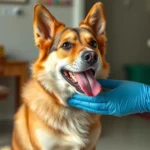
Introduction
Fear aggression in dogs is a complex behavior that many pet owners face, often leading to confusion and frustration. It manifests when a dog feels threatened or scared, prompting them to react aggressively as a means of self-defense. Misunderstandings about this behavior can lead to harmful consequences for both the dog and those around them, making it crucial to address and manage fear aggression effectively.
Addressing fear aggression in dogs is essential not only for the well-being of the dog but also for the harmony of human-dog relationships and community safety. A dog displaying fear aggression can pose a risk to other animals and people, leading to potential injuries or accidents. Therefore, understanding the roots and manifestations of this behavior is vital for responsible dog ownership.
In this article, we will cover the following topics:
– Understanding fear aggression and its causes
– Assessing the severity of fear aggression
– Managing fear aggression through training and environmental adjustments
– Health considerations related to fear aggression
– The role of socialization in preventing and managing fear aggression
– Owner responsibility and education on handling fear aggression
Understanding Fear Aggression
What is Fear Aggression?
Fear aggression occurs when a dog perceives a threat and reacts defensively. This behavior can be characterized by growling, barking, lunging, or even biting when they feel cornered or scared. It’s important to differentiate fear aggression from other types of aggression, such as dominance aggression or territorial aggression. Fear aggression is rooted in anxiety and insecurity, making it a response to perceived danger rather than a desire to dominate or control.
Causes of Fear Aggression
Several factors contribute to the development of fear aggression in dogs:
-
Genetic Predisposition: Certain breeds are more prone to anxiety and fear-based behaviors due to genetic factors. Understanding your dog’s breed characteristics can provide insight into potential behavioral issues.
-
Early Socialization Experiences: A lack of exposure to diverse environments, people, and other animals during the critical socialization period (typically between 3 and 14 weeks) can lead to fear aggression later in life. Dogs that have not been adequately socialized may react fearfully to unfamiliar situations.
-
Traumatic Events: Dogs that have experienced trauma, such as abuse, neglect, or a serious accident, may develop fear-based aggression. The memory of the trauma can trigger defensive reactions in similar situations.
-
Environmental Factors: Stressful environments, such as loud noises, crowded spaces, or chaotic households, can exacerbate anxiety in dogs, leading to fear aggression.
Signs of Fear Aggression in Dogs
Recognizing the signs of fear aggression in dogs is crucial for effective intervention:
-
Body Language Signals: Dogs exhibiting fear aggression may display lowered tails, flattened ears, and tense body posture. These signs indicate that the dog is feeling threatened.
-
Behavioral Signs: Growling, barking, and lunging are common behaviors associated with fear aggression. Some dogs may also show avoidance behaviors, such as trying to hide or escape.
-
Situational Triggers: Understanding what specifically triggers your dog’s fear aggression is key. Common triggers include strangers, loud noises, or other animals.
Assessing the Severity of Fear Aggression
Behavioral Assessment Techniques
If you suspect your dog exhibits fear aggression, a professional evaluation is essential. Veterinarians and certified behaviorists can conduct comprehensive assessments to determine the severity of the behavior and its underlying causes. Techniques may include observing the dog in various situations and noting their responses.
Understanding Triggers
Identifying specific triggers for your dog’s fear aggression is critical. Keeping a behavior diary can help you track incidents, noting the context in which the aggressive behavior occurs. This record can provide valuable insights into patterns and help professionals design a tailored behavior modification plan.
Consulting a Professional
Consulting a veterinarian or a professional dog trainer is vital when dealing with fear aggression. They can provide guidance on when to seek help and offer tailored behavior modification plans designed to address your dog’s unique challenges.
Managing Fear Aggression
Creating a Safe Environment
Establishing a secure home environment is the first step in managing fear aggression in dogs. This means creating a space where the dog feels safe and minimizing exposure to known triggers. Consider using baby gates or designated safe zones where your dog can retreat when feeling overwhelmed.
Desensitization Techniques
Desensitization is a gradual process that involves exposing your dog to their triggers in a controlled and positive manner. Start at a distance where your dog feels safe and gradually decrease the distance over time. Pair these exposures with positive reinforcement, such as treats or praise, to create positive associations.
Training and Behavior Modification
Training is a crucial aspect of managing fear aggression. Techniques such as counter-conditioning and clicker training can be effective. Consistency in training routines is key; use the same commands and methods to avoid confusing your dog. Positive reinforcement encourages desired behaviors and helps build your dog’s confidence.
Use of Leashes and Muzzles
For safety, using leashes and muzzles can be beneficial when managing fear aggression in dogs. Properly fitted muzzles can prevent biting while allowing the dog to breathe and drink. It’s important to introduce the muzzle gradually and positively to avoid further anxiety. Always supervise interactions and use a leash in unfamiliar situations.
Health Considerations
Physical Health and Fear Aggression
Physical health issues can exacerbate fear aggression in dogs. Conditions such as pain or illness can make a dog more irritable and prone to fearful reactions. Regular veterinary check-ups are essential to rule out any underlying health problems that may contribute to aggressive behavior.
Behavioral Medications
In some cases, behavioral medications may be necessary to help manage fear aggression. These medications can help reduce anxiety levels and make behavioral modification training more effective. Always discuss medication options with your veterinarian to determine the best course of action for your dog.
The Role of Socialization
Importance of Early Socialization
Early socialization is crucial in preventing fear aggression in dogs. Exposing puppies to a variety of environments, people, and other animals during their formative weeks can significantly reduce the likelihood of fear-based behaviors in adulthood. Engaging with positive experiences helps build confidence and resilience.
Continued Socialization for Adult Dogs
Socialization shouldn’t stop after puppyhood. Adult dogs can benefit from continued exposure to new experiences and environments. Techniques such as enrolling in obedience classes, participating in dog playgroups, or joining socialization workshops can provide valuable opportunities for ongoing socialization.
Owner Responsibility and Education
Educating Yourself as a Dog Owner
As a dog owner, it’s your responsibility to educate yourself about canine behavior. Understanding the nuances of fear aggression can help you respond appropriately to your dog’s needs. Numerous resources, including books, articles, and online courses, are available to help you learn more about dog behavior and care.
Building a Support System
Connecting with other dog owners and seeking out trainers or behaviorists can provide valuable support. Sharing experiences and strategies can help you manage your dog’s fear aggression more effectively. Look for local support groups or online forums dedicated to dog behavior.
Conclusion
Understanding and managing fear aggression in dogs is a multifaceted process that requires patience, commitment, and knowledge. By recognizing the signs, assessing the severity, and implementing effective management strategies, you can help your dog feel more secure and confident. Educating yourself about canine behavior and building a support system can further enhance your ability to provide a loving and understanding environment for your fearful dog. With dedication and the right approach, you can foster a positive relationship with your dog, ensuring their well-being and enhancing your shared experiences.









